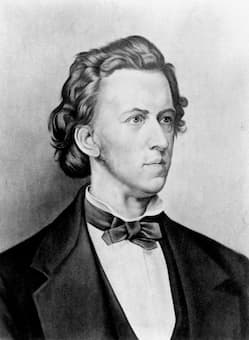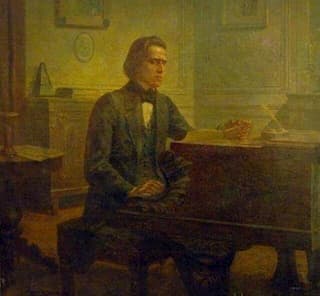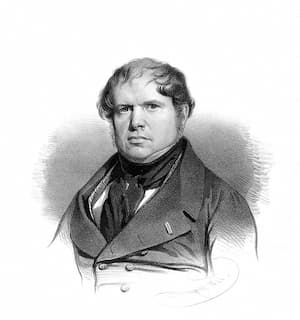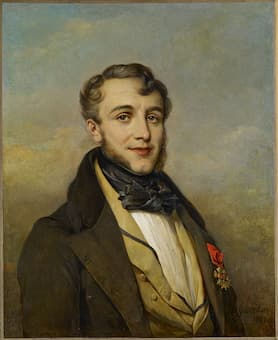It's all about the classical music composers and their works from the last 400 years and much more about music. Hier erfahren Sie alles über die klassischen Komponisten und ihre Meisterwerke der letzten vierhundert Jahre und vieles mehr über Klassische Musik.
Total Pageviews
Saturday, October 12, 2024
The Magical World of Musicals | The Lion King | The Greatest Showman
Friday, October 11, 2024
11 October: Frédéric Chopin’s Piano Concerto No. 1 Was Premiered
by Georg Predota

Frédéric Chopin, 1873
On 22 September 1830, Frédéric Chopin invited all of musical Warsaw to his home for a dress rehearsal of his E-minor Concerto. The rehearsal was enormously successful and a press review announced, “I hasten to bring a piece of good news to all friends of music and of native talent: Frédéric Chopin has completed his second grand piano Concerto. It is a work of genius, original, gracefully conceived with an abundance of imaginative ideas and perfect orchestration. The performance was masterfully executed… and we must add that Mr. Chopin will rob the Warsaw public of great pleasure if he departs without having publically produced this second Concerto.” Glowing accolades none withstanding, let us clear up some possible confusion. The referenced E-minor Concerto was the first of Chopin’s two piano concertos to be published, and it was subsequently given the opus number 11. It was composed immediately after the premiere of the F-minor concerto, which took place on 17 March 1830. This composition was published as his Piano Concerto No. 2 and given the opus number 21. As such, the E-minor concerto was composed and performed second but published first. The public premiere performance took place on 11 October 1830 at the Teatr Narodowy (National Theatre) in Warsaw, Poland, with the composer as the soloist.

Chopin playing piano © reddit
Chopin writes about his performance, “I was not the slightest bit nervous and I played as I play when I am alone. It went well. The hall was full. Goerner’s Symphony came first. Then My highness played the first allegro of the E minor Concerto, which I reeled off on a Streicher piano. The bravos were deafening… It seems to me that I have never been so much at ease when playing with an orchestra. The audience enjoyed my piano playing.” Rising political tensions prevented extended press reviews, and the local newspaper merely describes it as “one of the most sublime of all musical works,” but hardly the ecstatic tribute paid to the F-minor concerto earlier that year. Chopin performed the “Rondo” of the E-minor in Breslau 14 days later, and wrote to his family that the Germans had declared, “How light his touch as a pianist was.” However, Chopin complained, “that there was not a word written about the composition itself.” One local critic, however, “praised the novelty of the form, saying that he had never yet heard anything quite like it. “Perhaps” Chopin opined, “he understood better than any of them.” And a Munich performance in 1831 prompted the reviewer to write, “A lovely delicacy along with a beautiful and individualistic interpretation of the themes was characteristic of his cultivated style. On the whole, the work was brilliant and well written but without any particular originality or depth except for the main theme and middle second of the Rondo, which display a unique charm in their peculiar combination of melancholy and light-hearted passages.”

François-Joseph Fétis
Once the E-minor concerto had made its way to Paris, François-Joseph Fétis, one of the most influential music critics of the 19th century writes, “M. Chopin performed a concerto that caused as much astonishment as pleasure because of the novelty of its melodic ideas as well as its figuration, modulations, and form in general. His melodies are soulful, his keyboard writing imaginative, and originality prevails throughout. But mixed in with the qualities I have just identified are such weaknesses as over-rich modulations and a disordered succession of phrases, so that sometimes one had the impression of listening to an improvisation rather than composed music.” These early reviews decidedly colored the reception of the E-minor Concerto in the early twentieth century.

Frédéric Kalkbrenner, 1829
James Huneker dismissed it claiming “not Chopin at his very best,” and specifically writing on the E-minor he observed that “the first movement is too long, too much in one set of keys, and the working out section too much in the nature of a technical study.” And Donald Francis Tovey writes in the 1930’s that “the first movement of the E minor is built on a suicidal plan,” suggesting that it lacked “an essential element of harmonic contract and was therefore deficient from a structural point of view.” Critics initially might also have been guided by the dedication of the E-minor concerto to Frédéric Kalkbrenner, who was after all in the running to become Chopin’s teacher in Paris. However, today we understand that Chopin used virtuosity of differentiated intensity, inviting fluid interpretation and expression from his most technical writing. As has been observed, the E-minor concerto derives its “energy and momentum not from the contract of tonal centers, but from the contrast of lyric and virtuosic sections in the piano writing.”
Thursday, October 10, 2024
What YOUR favorite composer says about you!
Wednesday, October 9, 2024
Pink Floyd - Shine On You Crazy Diamond (Parts 1-5 & 7) [PULSE Restored ...
Last Words and Cause of Death of Famous Composers
Tuesday, October 8, 2024
A letter from Prague: the city in timeless harmony
Hattie Butterworth
Tuesday, October 8, 2024
Exploring the city’s cultural identity through architecture, history, and the legacy of Czech music
Prague is a city that architecturally is vaguely reminiscent of many places. I visited Prague for the first time earlier this summer, and found myself with memories of Italy, Germany and Scandinavia in my mind as I walked the cobbled streets. Then it has its political markers – the Lennon Wall with its ever-changing graffiti, marking global causes and the Memorial to the Victims of Communism active in Czechoslovakia between 1948 and 1989.
Its music – the distinctive Bohemian legacy of Dvořák, Suk, Smetana and others – perhaps gives the city an extra dimension to its colour. ‘My music is rhythmic because I am Czech,’ Bohuslav Martinů once said. ‘The national music of the Czechs is rhythm – strong and agile rhythm.’
But it was Bedřich Smetana (1824-1884), who was perhaps the first composer to revive the Czech musical language. A pioneer in his own right, he is now known in the country as the ‘father of Czech music’. This shift to writing in Czech came as later in life, he further embedded himself in Czech culture by learning to speak the language and the Czech nationalist movement caught wind. His own first language, as was usual among the middle classes in the Habsburg empire, was German.
Strong and lyrical, the Czech language has West-Slavic origins and is distinctly different to the German language of Smetana’s upbringing. Listening to the discussions of Czech audiences felt like a further journey into the music of the country. As I settled down in the National Theater for a production of Smetana’s late opera The Secret, the pastel and gold colours of the building glimmered and the strong, lyrical language reduced to whispers.
 The interior of the National Theatre, Prague | Photo: National Theatre Prague
The interior of the National Theatre, Prague | Photo: National Theatre Prague
The Czech National Opera has commitment to celebrating its composer, Smetana, in his 200th anniversary year as part of the ‘Year of Czech Music’. The Secret lives alongside eight other Czech operas that Smetana wrote whilst principal conductor of Prague’s Provisional Theatre, the temporary home for Czech drama and opera before the National Theatre was built. Libuše (The Kiss) has also seen a new production this year, as well as revivals of The Bartered Bride and Dalibor.
Smetana’s operas blend the folk songs of his homeland with his personal style and have a poetic musical language. So too does his orchestral music, the most famous of which, his Má vlast was composed towards the end of his life and in the symphonic poem style pioneered by his friend Franz Liszt. Just as he began writing the work in 1874, Liszt lost the hearing in his left ear and a month later had also lost hearing in his right. He completed the work profoundly deaf.
By the end of 1874, Smetana resigned from his position as a conductor of the Provisional Theatre, because he couldn't hear well enough to keep doing his job. He wrote in his diary at the time: ‘If my disease is incurable, then I should prefer to be liberated from this life.’ He also suffered severely from tinnitus and wrote the ‘high E’ pitch he was hearing in the last movement of Bedřich Smetana's String Quartet No. 1, ‘From My Own Life’. In the middle of the finale, the quartet breaks off, followed by this mysterious high note. I wonder if this was a form of healing for Smetana, as embedding a tinnitus pitch into music has been known to significantly reduce the volume of the pitch. Was Smetana writing to sooth, rather than protest?
Many have argued about what caused the composer’s deafness and later his mental illness, leading for his body to be exhumed twice. In 1987 antibodies were found that pointed to syphilis, though the diagnosis still isn’t conclusive.
 The Smetana Museum original manuscript of Smetana's opera The Kiss | Photo: Hattie Butterworth
The Smetana Museum original manuscript of Smetana's opera The Kiss | Photo: Hattie Butterworth
Learning of Smetana’s connections and tragedies came from the beautifully-curated Smetana museum, right on the Vltava river in a neo-renaissance building. It’s an intimate and moving experience, holding original letters and memorabilia from Smetana’s life. So too does the museum at Jabkenice, where a deaf Smetana composed many of his later works.
I often wonder about composers: does knowing about their lives matter or impact the way we hear the music? Perhaps the ins and outs of Smetana’s private life aren’t as important to the music as the knowledge is of his cultural journey throughout his life. When we listen to Smetana we are hearing a shift into a cultural identity and a start to the legacy we now know of the country’s music. It’s history through staves, scores and melodies.
 The Czech Philharmonic closing the Prague Spring Festival 2024 | Photo: Hattie Butterworth
The Czech Philharmonic closing the Prague Spring Festival 2024 | Photo: Hattie Butterworth
Gramophone’s Orchestra of the Year 2024 was voted as being the Czech Philharmonic Orchestra. On my trip in June I saw the orchestra at the Rudolfinum concert hall in an all-Czech programme of music to close the annual Prague Spring Festival. From Smetana and Dvořák to the European premiere of Miroslav Srnka's Superorganisms, it was a unique opportunity to understand a full spectrum of Czech music and witness its effect on me. Perhaps the constant thread is the folk music of the country – still influencing Czech composers to this day and giving an intergenerational connection and community to the audiences.
In a recorded speech to receive the award, the orchestra’s chief conductor Semyon Bychkov said: ‘this orchestra lived by navigating through the highs and the lows, always attached to the national musical tradition, keen to preserve its unique sound and expression.’ Prague is engulfed with music. Walk around with your headphones in – Dvorak’s symphonies hold new resonance, bringing this iconic river and architecture to life through sound and history.
2024 is the Year of Czech Music. Find out more at visitczechia.com
Ludwig Van Beethoven - Egmont Overture
Sunday, October 6, 2024
Evolution of Classical Music (1400 BC-1900 AD)
Olivia Rodrigo donates all Manila concert proceeds to Jhpiego Philippines
Jan Milo Severo - Philstar.com
October 7, 2024 | 9:18am
In a photo posted on Oct. 6, 2024, Olivia Rodrigo is seen visiting Jhpiego Philippines, a local nonprofit organization, which she donated proceeds of her concert to.
MANILA, Philippines — Filipino-American pop star Olivia Rodrigo donated all the proceeds of the Manila leg of her "Guts" World Tour to Jhpiego Philippines.
According to Olivia's Instagram story on Sunday, Jhpiego Philippines is "dedicated to improving the health and lives of women and girls in the Philippines, especially in underserved and conflict-affected areas."
Olivia posted her visit to the non-governmental organization's headquarters after her concert on her Instagram account.
"I’m so stoked that all the net ticket sales from last night could be donated to @jhpiego through my fund 4 good," Olivia wrote.
"I got to visit the organization while I was in Manila and was so impressed by the work they are doing providing healthcare to women and girls in the Philippines."
"It was the most special show and the most meaningful trip. To say I’m grateful doesn’t even cut it! Mahal kita," she added.
Olivia said that performing in the country was a dream come true for her.
"Been dreaming of this show for a whileeeee. My first time in the Philippines and also my biggest venue ever!!!!!" she said.
"Thank you to everyone Manila for welcoming me so generously and making me feel so loved and thank you to @americanexpress for making this show happen," she added.
Feast for the ears: PPO kicks off concert season

The Philippine Philharmonic Orchestra (PPO) recently kicked off its concert season at the Samsung Performing Arts Theater in Makati City with a bang.
Dubbed “Forte,” the show has PPO celebrating the symphonic might it has gained since it was founded some 40 years ago.
Dr. Jaime C. Laya, chairman of the Cultural Center of the Philippines’ (CCP) board of trustees, recalled in his welcome remarks how the PPO became the country’s premiere symphony orchestra. CCP president Kaye Tiñga, on the other hand, said the PPO has enriched the country’s performing arts scene in music by featuring both foreign as well as Filipino musical artists.
Saturday, October 5, 2024
Carlos Chavez - his music and his life
Carlos Antonio de Padua Chávez y Ramírez (13 June 1899 – 2 August 1978) was a Mexican composer, conductor, music theorist, educator, journalist, and founder and director of the Mexican Symphonic Orchestra. He was influenced by native Mexican cultures. Of his six symphonies, the second, or Sinfonía india, which uses native Yaqui percussion instruments, is probably the most popular.
Biography
National Conservatory of Music, México City
The seventh child of a criollo family, Chávez was born on Tacuba Avenue in Mexico City, near the suburb of Popotla. His paternal grandfather, José María Chávez Alonso, a former governor of the state of Aguascalientes, had been executed by the French Army in April 1864. His father, Augustín Chávez, who died when Carlos was barely three years old, invented a plough that was produced and used in the United States.
Carlos had his first piano lessons from his brother Manuel, and later on he was taught piano by Asunción Parra, Manuel Ponce, and Pedro Luis Ozagón, and harmony by Juan Fuentes. His family often holidayed in Tlaxcala, Michoacán, Guanajuato, Oaxaca, and other places where the cultural influence of the Mexican indigenous peoples was still very strong.
In 1916, Chávez and friends started a cultural journal, Gladios, and this led to his joining the staff of the Mexico City newspaper El Universal in 1924. In the succeeding 36 years he was to write over 500 items for this paper.
After the Mexican Revolution and the installation of a democratically elected president, Álvaro Obregón, Chávez became one of the first exponents of Mexican nationalist music with ballets on Aztec themes
In September 1922, Chávez married Otilia Ortiz and they went on honeymoon to Europe, from October 1922 until April 1923, spending two weeks in Vienna, five months in Berlin, and eight or ten days in Paris. During the latter visit he met Paul Dukas. Some months later, in December 1923, Chávez visited the United States for the first time, returning in March 1924. Chávez again went to New York City in September 1926 and stayed there until June 1928. Upon his return to Mexico, Chávez became director of the Orquesta Sinfónica Mexicana (Mexican Symphonic Orchestra), later renamed Orquesta Sinfónica de México (Mexico's Symphonic Orchestra); the country's first permanent orchestra, started by a musicians' labor union. Chávez was instrumental in taking the orchestra on tour through Mexico's rural areas.[citation needed]
In December 1928, Chávez was appointed director of Mexico's National Conservatory of Music—a position he held for a total of five years (until March 1933, and again for eight months in 1934). In that capacity, Chávez spearheaded three Spanish: academias de investigación, two concerned with collecting and cataloguing indigenous music and its literature, and the third to study the uses of old and new scales.
In 1937, Chávez published a book, Toward a New Music, which is one of the first books in which a composer speaks about electronic music. In 1938, he conducted a series of concerts with the NBC Symphony Orchestra, during a period of absence by the orchestra's regular conductor, Arturo Toscanini. In 1940 he produced concerts at New York's Museum of Modern Art, and by 1945, Chávez had come to be regarded as the foremost Mexican composer and conductor.
From January 1947 until 1952, Chávez served as director-general of the National Institute of Fine Arts. In his first year, he formed the National Symphony Orchestra, which supplanted the older OSM as Mexico's premier orchestra and led to the disbanding of the older ensemble. Throughout all this time, Chávez maintained a busy international touring schedule.
Chávez's tomb in the Panteón de Dolores, Mexico City
In May 1953 he was commissioned by Lincoln Kirstein, director of the New York City center of Music and Drama, for a three-act opera to a libretto by Chester Kallman based on a story by Boccaccio, to be titled The Tuscan Players. Intended to be finished in August 1954, it was first postponed to April 1955, but only finally completed in 1956, by which time the title had been changed twice, first to Pánfilo and Lauretta, then to El amor propiciado. The City Center waived its rights to the first performance, which was given under the title Panfilo and Lauretta in the Brander Matthews Theatre at Columbia University in New York on 9 May 1957, under the baton of Howard Shanet. Stage direction was by Bill Butler, scenic design by Herbert Senn and Helen Pond, and costumes by Sylvia Wintle. The principal singers were Sylvia Stahlman, Frank Porretta, Craig Timberlake, Mary McMurray, Michael Kermoyan, and Thomas Stewart. The opera would be revised twice more and the title changed again to Los visitantes (The Visitors), for productions in 1968 and 1973, in Mexico City and Aptos, California, respectively. From 1958 to 1959 he was the Charles Eliot Norton professor at Harvard University, and the public lectures he gave there were published as a book, Musical Thought.
From 1970 to 1973, Chávez served as the music director of the Cabrillo Festival of Contemporary Music. His orchestral composition Discovery (1969) had previously been commission by the Festival and was first performed there.[citation needed]
Failing health and financial setbacks forced Chávez to sell his house[when?] in the Lomas de Chapultepec neighborhood of Mexico City and move in with his daughter Anita in Coyoacán, in the fringes of the Mexican capital, where he died quietly on 2 August 1978, his wife having died in April.
Chávez's manuscripts and papers are housed in the Music Division of the New York Public Library for the Performing Arts and in the National Archive of Mexico, in Mexico City.
Musical style
Chávez's music does not fall into clear stylistic periods, but rather cumulates elements in a process of continual synthesis. The juvenilia, up to 1921 and consisting primarily of piano compositions, is essentially Romantic, with Robert Schumann as the main influence. A period of nationalistic leanings was initiated in 1921 with the Aztec-themed ballet El fuego nuevo (The New Fire), followed by a second ballet, Los cuatro soles (The Four Suns), in 1925.
During his time in New York City between 1924 and 1928, Chávez acquired a taste for the then-fashionable abstract and quasi-scientific music, as is reflected in the titles of many of his compositions written between 1923 and 1934: Polígonos for piano (Polygons, 1923), Exágonos for voice and piano (Hexagons, 1924), 36 for piano (1925), Energía for nine instruments (Energy, 1925), Espiral for violin and piano (Spiral, 1934), and an unfinished orchestral score titled Pirámides (Pyramids).
The culmination of this period was the ballet H. P. (i.e., Horse Power), also known by the Spanish title Caballos de vapor (1926–31). H. P. is a colorfully orchestrated score of ample dimensions and dense, compact atmosphere, notable for its dynamism and vitality, revealing the influence of Stravinsky and at the same time returning to folkloric and popular elements, with dances such as the sandunga, tango, huapango, and foxtrot.Such nationalisms would appear through the 1930s, notably in the Second Symphony (the Sinfonía índia of 1935–36, one of the few works by Chávez to quote actual Native-American themes), but only sporadically in later compositions. Diego Rivera designed the sets and costumes for the ballet's premiere in Philadelphia in 1932.
Although this early period saw the creation of the Sonatina for violin and piano (1924), it was only in the 1930s that Chávez returned to another of the main musical interests of his maturity, prefigured in the juvenilia: the traditional genres of the sonata, quartet, symphony, and concerto. He composed six numbered symphonies. The first, titled Sinfonía de Antígona (1933), was reworked from incidental music for Jean Cocteau's Antigone, an adaptation of Sophocles' tragedy. In it, Chávez sought to create an archaic ambiance through the use of modal polyphony, harmonies built on fourths and fifths, and a predominant use of wind instruments.
In the fourth of his Norton lectures of 1958–59, titled "Repetition in Music",[15] he described a mode of composition already observable in many of his compositions since the 1920s, in which "The idea of repetition and variation can be replaced by the notion of constant rebirth, of true derivation: a stream that never comes back to its source; a stream in eternal development, like a spiral ..."[16] A notable early example of this method is Soli I (1933), the first work acknowledged by the composer to have been consciously organized according to this principle. It only became a regular feature, however, beginning with Invención I for piano (1958), and subsequently in most of his instrumental compositions of the 1960s and 1970s: Invención II for string trio (1965), Invención III for harp (1967), Soli II for wind quintet (1961), Soli III for bassoon, trumpet, viola, timpani, and orchestra (1969), Soli IV for brass trio (1966), Cinco Caprichos for piano (1975), and the late orchestral works Resonancias (1964), Elatio (1967), Discovery (1969), Clio (1969), and Initium (1970–72).[17]


